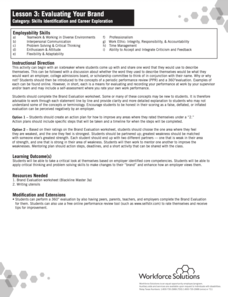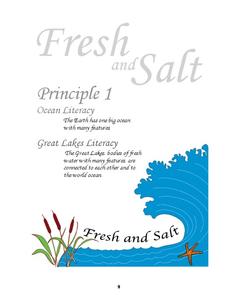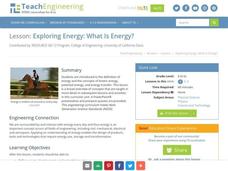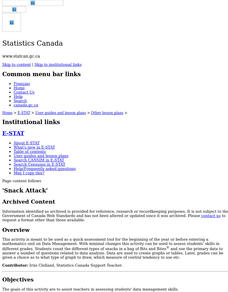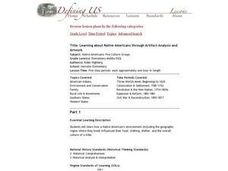Ontario
Critical Literacy—Media Texts
Media texts convey both overt and implied messages. As part of their study of media, class members analyze the language, form, techniques, and aesthetics in a variety of media texts.
Workforce Solutions
Evaluating Your Brand
After completing an evaluation worksheet that asks learners to rate their skills honestly, individuals create an action plan that includes specific steps to improve in these areas.
Curated OER
Count the Stars
Students research information about China and its languages and counting systems. They identify Chinese characters for numeral from one to ten and then create a counting tool to assess Chinese numerals and represent the Chinese culture.
National Wildlife Federation
Citizen Science to the Rescue!
You don't have to be a scientist or even out of high school to contribute to scientific research. In the 12th lesson in the series of 21, scholars use this opportunity to add to the growing body of scientific knowledge and consider the...
Roy Rosenzweig Center for History and New Media
Analyzing Political Campaign Commercials
Imagine a lesson that models for learners how to separate facts from opinions. How to detect bias. How to evaluate a source of information. How to identify propaganda. Although designed for middle schoolers, the activities in this packet...
Centers for Ocean Sciences
Ocean and Great Lakes Literacy: Principle 1
Is your current lesson plan for salt and freshwater literacy leaving you high and dry? If so, dive into part one of a seven-part series that explores the physical features of Earth's salt and freshwater sources. Junior hydrologists...
National Endowment for the Humanities
Cultural Change
High schoolers research the passage of the 19th Amendment as an illustration of the mutual influence between political ideas and cultural attitudes. They also read the Seneca Falls Declaration and explore the cultural shifts it both...
Discovery Education
Mood Music!
Grouchy? Sad? Here's a great resource that shows kids how music can be used to lift their spirits. Kids collect and chart data on the effects of music on emotions. After analyzing the results of their experiment, they develop their own...
Washington Office of Superintendent of Public Instruction
Using Our Senses to Observe
Look around and explore. Little ones use their five senses with some day-to-day activities designed to guide observation and apply STEM strategies. Young scientists learn through comparing/contrasting and observing with magnifiers as...
Journey Through the Universe
Voyage of Discovery
Did you know that Pluto is smaller than the United States of America? It is difficult to conceptualize the size of planets and the distance between them, and the lesson addresses those exact issues. After a discussion, pupils create...
Teach Engineering
Exploring Energy: What Is Energy?
...Then the water heater exploded like a bomb. Using a video of an exploding water heater, the resource presents the definitions of energy, potential energy, and kinetic energy to be used in later lessons of the unit.
Curated OER
Jobs Past and Present
Middle schoolers discover how jobs have changed from the past to today. In groups, they identify the varoius tools and resources used both in the past and today and discuss how they are different. As a class, they discuss the impact of...
Curated OER
People Of The Plains
Learners engage in a activity that discusses how Native Americans lived in all different parts of North America. They focus on investigating the region's natural resources and how the indians used them to build shelter, make clothing,...
Curated OER
Encyclopedia Expertise
Fourth graders, in groups, practice using the encyclopedia as a reference tool. They research animals today using the encyclopedia. Their job be to find three or more strange but true facts about the animal listed on their card.
Curated OER
Sculpture
Sixth graders explore the art of sculpture. They examine the sculptural techniques that can be used. Students select sculptural materials, tools, and techniques to create a novel interpretation of an everyday object.
Curated OER
Let's Debate - Demonstrating Effective Communication Skills
Students explore and engage in the art of debate. When both sides have been presented each pair have a few minutes to prepare a rebuttal based upon what the opposing side has said. A rubric imbedded in this plan is used as an assessment...
Curated OER
Studying An Artist
Students examine the artwork of a specific artist and attempt to create a painting in the style of the studied artist in this middle and high school level Art lesson. Rubric is included for self- and teacher assessment after the project...
Curated OER
Native American Blocks
Students research information about a Native American tribe and document their knowledge by creating a block (cube) containing pictures about the homes, tools, food, clothing, and transportation for this tribe.
Curated OER
Earthquake Epicenter
Students use chart data to determine the location of the epicenter of an earthquake. This task assesses students' abilities to generalize and infer, organize data, interpret data, and apply mathematical concepts.
Curated OER
Occupations
Students listen to Maybe You Should Fly A Jet! Maybe You Should Be a Vet. In this occupations lesson, students define occupation and make a job drawing of them and their job choice. Students become familiar with tools for each job.
Curated OER
Magnificent Microscopes
Young scholars use a microscope in a series of activities that are designed to help them explore the "invisible world" and make meaningful microscopic discoveries and learn the importance of the microscope as a tool in science and research.
Curated OER
Adding Integers with Counters
Students add integers and use counters to create a visual. In this algebra lesson, students work in pairs as they use the computer to add integers. They complete an assessment on adding integers at the end of the activity.
Curated OER
Snack Attack
Students design charts, tables, graphs, and pictographs to analyse the types of snacks in a bag.
Curated OER
Learning about Native Americans through Artifact Analysis and Artwork
Sixth graders assess how a Native American's environment and the geographic region where they lived influenced their food, clothing, shelter and the overall culture of a tribe. They study the impact of conservation, family, rural life,...
Other popular searches
- Self Assessment Tools
- Music Assessment Tools
- Assessment Tools for Science
- Assessment Tools Coins
- Assessment Tools for Math
- Assessment Tools for Music
- Assessment Tools Singing
- Assessment Tools Lesson Plan
- Self Assessment Tools
- Assessment Tools + Coins



